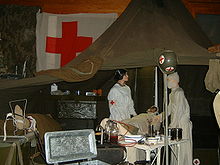
Back Simboli Međunarodnog pokreta Crveni krst i Crveni polumjesec BS Έμβλημα Κόκκινου Κρυστάλλου Greek Cruz Roja#Los emblemas Spanish Punase Risti embleem Estonian نشانهای سازمان صلیب سرخ جهانی و جنبش هلال احمر Persian Punainen risti (tunnusmerkki) Finnish Emblèmes de la Croix-Rouge French סמל המעוין האדום HE A Vöröskereszt jelképei Hungarian Կարմիր բյուրեղ Armenian




Under the Geneva Conventions, the emblems of the International Red Cross and Red Crescent Movement are to be worn by all medical and humanitarian personnel and also displayed on their vehicles and buildings while they are in an active warzone, and all military forces operating in an active warzone must not attack entities displaying these emblems. The International Red Cross and Red Crescent Movement recognizes four protection emblems, three of which are in use: the Red Cross (recognized since 1864), the Red Crescent (recognized since 1929), the Red Lion and Sun (recognized since 1929; unused since 1980), and the Red Crystal (recognized since 2006).
The Red Cross was the original protection symbol declared at the First Geneva Convention in 1864. The Red Crescent, which was first used by the Ottoman Empire in the 1870s, and the Red Lion and Sun, which had been used only in Iran between 1924 and 1980, were both formally recognized as protection symbols following a 1929 amendment to the Geneva Conventions. Controversy stemming from the movement's successive rejections of the Red Star of David, which was established in 1899 and has been used only in Israel, led to the creation of the Red Crystal as the fourth protection symbol by a vote in 2005. In 2006, the movement announced that it was officially adopting the Red Crystal as a neutral symbol and that it was also granting formal recognition to Israel's Magen David Adom alongside the Palestine Red Crescent Society.
In popular culture, the red cross symbol came to be a recognizable generic emblem for medicine, commonly associated with first aid, medical services, products, or professionals; it has been unlawfully used in toys, movies, and video games, outside of its defined context. After objections from the movement, derivatives and alternatives have come to be used instead. Additionally, Johnson & Johnson has registered the symbol for their medicinal products. The appropriation of the symbol has led to further irritation due to the practice of hospitals, first aid teams, and ski patrols in the United States reversing the symbol to a white cross on a red background—so undoing the original idea of the Red Cross emblem, namely reversing the Swiss flag—thus inappropriately suggesting an affiliation with Switzerland.[1]
- ^ Philip F. Stahel (7 May 2013). "Swiss flag or Red Cross emblem: why the confusion?". Patient Safety in Surgery. 7 (13). London, UK: BioMed Central: 13. doi:10.1186/1754-9493-7-13. PMC 3663670. PMID 23648084.
After eliminating legal ramifications as a potential deterrent from appropriate use of the Red Cross symbol, the remaining explanation is simple unawareness about the formal distinction from the Swiss national flag. Until formal clarification, we will continue to encounter emergency departments masked as Swiss embassy satellite offices (Figure 2), and ski patrollers disguised as Swiss citizens in the Rocky Mountains (Figure 1).
© MMXXIII Rich X Search. We shall prevail. All rights reserved. Rich X Search